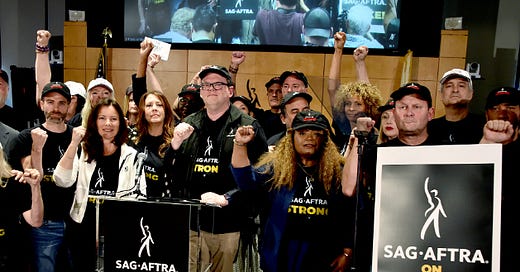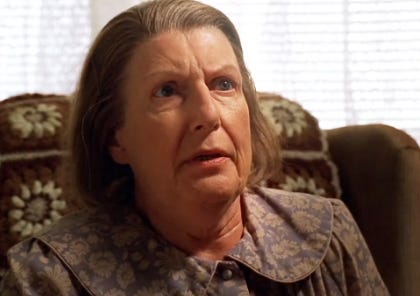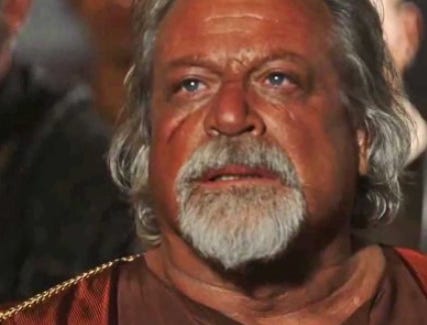What do the following characters have in common?
Livia Soprano (Nancy Marchand) in “The Sopranos”
and Proximo (Oliver Reed) from “Gladiator”?
Give up? Both of them had died during production, and they needed to manufacture CGI scenes of them in order to finish their roles in the show/films they were in. Both of those happened in the early 2000s. The technology has vastly improved since then.
Imagine if you will Rod Serling1 opening a show with his familiar monologue. A new show on television with a new name, new writing, new characters. Yet the writing contains familiar beats and cadences, the actors look similar to all A List celebrities and you can’t really believe it’s Serling because he’s been dead for almost 50 years. Yet all the writing was created by chatbots, all the “actors” are in fact computer generated and only exist on film and the studios don’t have to even pay for Serling’s image because they own the rights to The Twilight Zone and merely used his previously filmed visage and deepfaked the dialogue.
This is the future of filmmaking. Don’t believe it can be done yet today? Watch Jordan Peele imitate Barack Obama with a deepfake video.
Now imagine a Morgan Freeman sound alike getting paid a very low wage to imitate Freeman in a movie. Or imagine taking Brad Pitt’s face and placing it on a stand-in’s body as he works in an action film. Studios get the ability to reuse images and likenesses they already have the rights to, but don’t have to pay the actors an additional cent. That $20 million you have to pay an actor in a movie just went down to $20,000. Seem outlandish? It’s already been done. In “The Curious Case of Benjamin Button,” as part of the process to make Brad Pitt look younger at one point in the film, they took the image of him from a previous movie he made when he was younger, “Cool World” and used that as a stand in, with Pitt delivering his dialogue through the old image. That film came out 15 years ago. Imagine being able to do it today, with better CGI and with a cheaper actor giving the dialogue and that’s the scenario we’re talking about.
Now imagine if you can get an AI created to mimic Pitt’s voice. He’s done enough films and interviews so that there would be plenty of inputs for the AI to grasp his verbal tics, pitch, speech patterns, volumes, etc. The technology to do this has been around for awhile. When throat cancer took Roger Ebert’s voicebox and lower jaw, a company went about recreating his voice. Here is a TED talk in which he describes the technology, process and demonstrates the recreation of his human voice.
https://www.ted.com/talks/roger_ebert_remaking_my_voice?utm_campaign=tedspread&utm_medium=referral&utm_source=tedcomshare
Taken together you can recreate a huge movie star in the aggregate with just the cost of some computer programmers and an AI program. In addition, AI doesn’t complain, does exactly what you want it to, and doesn’t need breaks, makeup or it’s own trailer. The lighting, position and wardrobe can just be customized to accommodate whatever the director wants it to be. You can already see why studios are liking the possibilities here. We’d be living in a world where bankable stars never age, always look good, and sound real in movies that make billions and they don’t receive a penny for it.
The same technology can replace the actors in background roles in studio and streaming productions — minimal roles listed in the credits with titles like “second police officer” or “elevator man #2.” These roles generate a huge number of the jobs that SAG-AFTRA members depend on to pay bills. Those jobs may be obsolete very soon.
According to CNN, as of now, the two sides don’t even agree on what proposal the studios have on the table about AI use going forward. The Alliance of Motion Pictures and Television Producers (AMPTP), which represents the studios and streaming services in negotiations, said its proposal provides new AI protections for actors, and that it “protects performers’ digital likenesses, including a requirement for performer’s consent for the creation and use of digital replicas or for digital alterations of a performance.”2 But that just means to get a job an actor can provide his consent to the studio for all likenesses from the film. This is often done for marketing purposes but is just as likely to be used in future films, such as Pitt in Benjamin Button.
In any event, it is a good thing that they are ironing out what the rules will be regarding this technology for films in this strike. Unfortunately, for the rest of us, I don’t suspect our politicians in Washington have begun the discussions of what rights we have to our likenesses, voices or images in this capacity, and it will be some time before the law changes to reflect our mercurially changing technological society.
PurpleAmerica’s Obscure Fact of the Day
You may think that this is a new phenomenon. In actuality, you have to go back to 1985 for the first fully CGI character to appear in film.
In “Young Sherlock Holmes,” a priest who is hallucinating imagines a stained glass image of a knight coming to life. The entire knight “character” was CGI. Filmsite.org writes that this stained glass knight is regarded as the first "fully 3-D digital (or CGI), or computer generated, photorealistic animated character in a full-length feature film." It was also the first computer-animated character to be "scanned and painted directly onto film using a laser."
John Lasseter, working for George Lucas at Industrial Lights and Magic at the time created this scene. After Lucas’ “Howard the Duck” bombed, Lucas was forced to sell the animation division to Steve Jobs, who rebranded it as PIXAR. It’s first major project was a fully created 3D animated movie you may have heard of, Toy Story. Lasseter has gone on to win multiple Oscars at Pixar and is considered to run one of the best CGI animation studios in the world.
But that had no speaking and was an illusion seen by the priest. If you want to know the first interactive character fully CGI created, well, you have to go to the well of infamy here, and George Lucas was responsible for that one too. In 1999, Lucas began his “prequel trilogy” to Star Wars with “Star Wars Episode I: The Phantom Menace.” One of the characters was a gangly looking “gungan” by the name of Jar Jar Binks. He would be the first fully created CGI interactive character. Needless to say, Jar Jar Binks is not a very well loved character.
But it did not take long for CGI characters and acting to take a foothold. The main actor responsible for this is Andy Serkis and his mesmerizing performance of Gollum in the “Lord of the Rings” movies (Fellowship of the Ring came out in 2001). Both the actor voicing the character and simulating the movements and the CGI layered over him on film provide the feeling of an actual being there and the character shines through.
Now, CGI characters have become so prolific, there are many CGI characters and it is often impossible to discern when a character is real or not.
Like what you are seeing here at PurpleAmerica? Share and Comment. Let your friends and family know! Forward us topics you’d like us to discuss! It’s am open community here.
Footnotes and Fun Stuff
For those who don’t know who Rod Serling is, he was the creator of The Twilight Zone and opened every episode with a monologue where he would begin, “Imagine if you will…”
https://www.cnn.com/2023/07/18/business/ai-actors-strike/index.html







